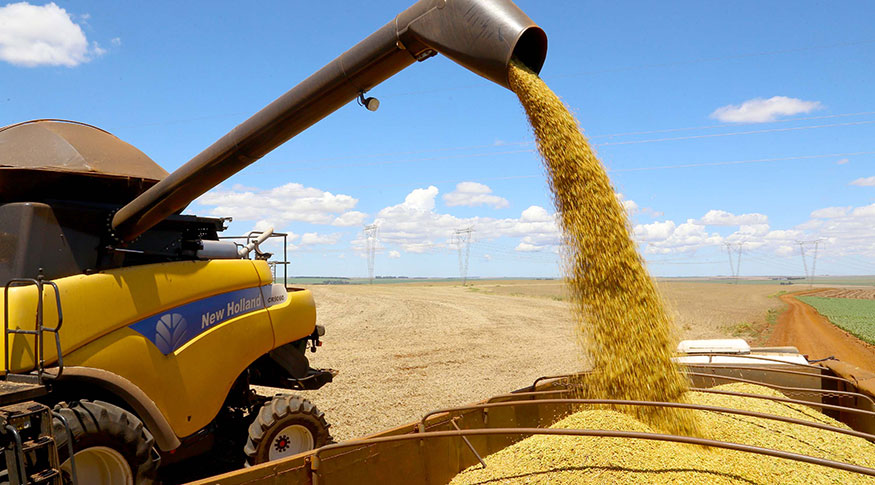Agricutural production
June estimate points to harvest 6.2% smaller in 2024, still reflecting unfavorable weather conditions in the year
July 11, 2024 09h00 AM | Last Updated: July 11, 2024 02h48 PM

The Brazilian harvest of cereals, legumes and oilseeds should reach 295.9 million tonnes, according to the June estimate of the Systematic Survey of Agricultural Production (LSPA), released today (11) by the IBGE,
This result is 6.2% lower (or 19.5 million tonnes) than the harvest obtained in 2023 (315.4 million tonnes) and 0.3% lower (940.3 thousand tonnes) than the May estimate.
The area to be harvested was of 78.3 million hectares, a growth of 0.6% (462.7 thousand hectares) over the area harvested in 2023 and an increase of 8,220 hectares (0.0%) in relation to May. Only cotton hit a record in the output, with a growth of 9.8%, due to the increase of 12.5% in the harvested area.
"The 2023/2024 harvest suffered several problems since the beginning, like lack of rainfall and high temperatures during the summer harvest (first harvest), causing some areas to be replanted. Rio Grande do Sul faced excesso f rainfall and floods. With the second harvest of corn, we have noticed that these problems were more significant than expected. The states that faced the major reassessments were Minas Gerais, with a drop of nearly 900 thousand tonnes, Paraná and Bahia. On the other hand, the estimated output of rice grew in Tocantins," assesses Carlos Alfredo Guedes, the IBGE Manager of Agriculture.
Carlos Barradas, manager of the LSPA, notes that although the losses expected with the floods in Rio Grande do Sul are not fully reflected in the survey, the reduction in the production reflects the impact of unfavorable weather conditions occurred in 2023 and 2024, not only the excess of rainfall, but also a drought in the Cerrado biome in some states, especially Minas Gerais, Mato Grosso, Goiás and Mato Grosso do Sul. In Rio Grande do Sul, the IBGE has been stepping up efforts to raise the losses due to the excess of rainfall and floods.
In June, the estimated output of wheat is growing 23.7% in relation to 2023. However, it is partly due to the low comparison basis of the harvest in the previous year, when the production was very impacted by unfavorable weather conditions. In view of the problems with the excess of rainfall and floods in the state, it is possible that these figures do not sustain, as losses in the soil in the planting areas are not known yet. Moreover, the prices of the product are not helping.
Along June, we continue to ascertaining the losses occurred in the South and in the Cerrado. Nevertheless, we had a fair output of coffee, a record in the production of cotton and an increase of 0.1% or 140,946 tonnes of soybeans, for which the market initially estimated a higher reduction. The estimates for the output of beans - 3rd crop (5.7% or 42,201 t), rice (1.8% or 188,812 t), beans - 1st crop (1.3% or 12,485 t), beans - 2nd crop (0.2% or 2,534 t) increased”, highlights Barradas, noting that the increase in the supply is important as it reduces the pressure on the retail prices.
The estimate for soybeans is of an output of 146.8 million tonnes, a decrease of 3.4% in relation to the production in the previous year. For corn, a drop of 13.3% is estimated (reductions of 15.0% in corn - 1st crop and of 12.8% in corn - 2nd crop). The output should reach 113.7 million tonnes. Sorghum is another product with a significant drop and should reduce the production by 10.4%, reaching 3.9 million tonnes.
Another good news is the increase in the output of rice to 10.7 million tonnes, an increase of 1.8% in relation to the estimate of the previous month and an increase of 4.1% in relation to the volume produced in 2023. This increase is due to the planted area, which rose 6.7%, whereas the average yield retracted 2.8%. In June, Tocantins positively reassessed its estimated production and it should reach 764.3 thousand tonnes. The output of rice in 2024 should closely address the domestic consumption in Brazil.
About the LSPA
Launched in November 1972 aiming at addressing the demand of users for monthly short-term statistical information, the LSPA provides estimates of planted area, harvested area, amount produced and average yield of products selected based on criteria of economic and social importance for Brazil. It does not only monitor each crop investigated in the calendar year of reference, from the intention to plant up to the end of the harvest, but also presents the forecast for the coming year, with surveys in the months of October, November and December. See available data on Sidra. The next release of the LSPA will be on August 13.


















